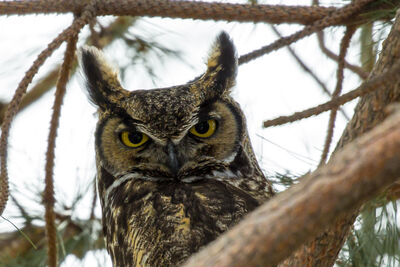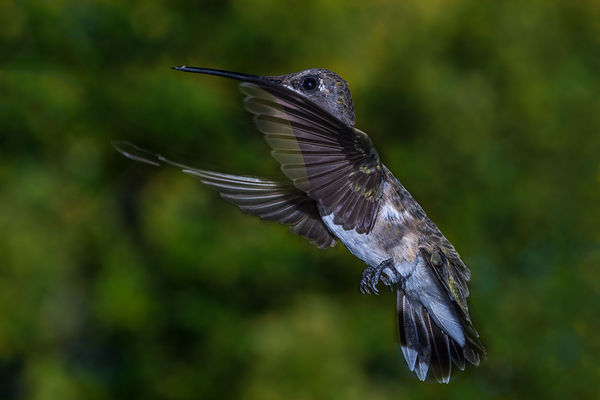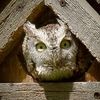Hummers in flight
Jul 31, 2015 01:12:31 #
A couple shots of some juvenile Black-chinned hummingbirds.
They are so fascinating to observe while performing their aerial acrobatics.
They are so fascinating to observe while performing their aerial acrobatics.


Jul 31, 2015 01:23:46 #
Wow, superb! Beautifully and skillfully captured.
Never heard of that species of hummer.
Never heard of that species of hummer.
Jul 31, 2015 02:03:39 #
Can you please re-post these same images, but this time check the box labeled (store original)? Thank you.
Jul 31, 2015 02:09:43 #
Nikonian72 wrote:
Surely.Can you please re-post these same images, but this time check the box labeled (store original)? Thank you.
Jul 31, 2015 02:13:27 #
Excellent resolution! Especially image #1.
I was hoping to see Exif info, but not attached on either image. Can you tell us a bit about camera, lens, speedlight, HSS or not?
I was hoping to see Exif info, but not attached on either image. Can you tell us a bit about camera, lens, speedlight, HSS or not?
Jul 31, 2015 02:32:52 #
Nikonian72 wrote:
Here's the exif data. I used two speedlights (SB-900 & SB-600), both at 1/16th power to provide a flash duration of approximately 1/10,000 of a second. That's the only way I could "freeze" the wings. No HSS.Can you tell us a bit about camera, lens, speedlight, HSS or not?
EXIF for the 1st photo
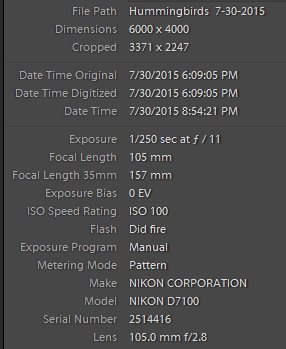
EXIF for the 2nd photo
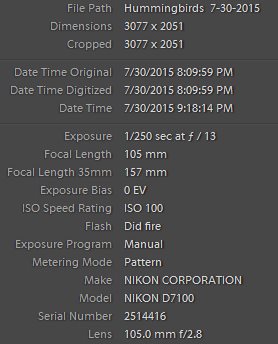
Jul 31, 2015 04:55:03 #
Frank S wrote:
Well done! Nice ratio on the lighting. It is so well balanced that I cannot tell the direction of either speedlight.I used two speedlights (SB-900 & SB-600), both at 1/16th power to provide a flash duration of approximately 1/10,000 of a second.
Jul 31, 2015 10:29:58 #
Nikonian72 wrote:
The SB-900 was actually on the camera. The SB-600 placed in front and below the bird, in both photos. Thank you very much for the kind words. You are one of the members here who have encouraged & assisted me over the years in such a positive way. Thanks again.Well done! Nice ratio on the lighting. It is so well balanced that I cannot tell the direction of either speedlight.
Jul 31, 2015 10:32:50 #
Two super shots, William! Would you care to give us some more information on your technique? It would be a great educational tool for our members. For example, why not use High Speed Synch? Where did you place the flash units? How close was the camera? Were you using a remote release? How did you determine your exposure for the ambient and the flash? Lots of questions!
Aug 1, 2015 00:14:57 #
I am also interested in speedlight settings: manual or auto? And what power output (1/8, 1/4, 1/2, etc.)?
Aug 1, 2015 02:37:22 #
birdpix wrote:
Two super shots, William! Would you care to give us some more information on your technique? It would be a great educational tool for our members. For example, why not use High Speed Synch? Where did you place the flash units? How close was the camera? Were you using a remote release? How did you determine your exposure for the ambient and the flash? Lots of questions!
Glad to help, if I can. I'm trying to teach myself good use of Speedlights, so I challenged myself to try and freeze the wings during broad daylight with a very high ambient light.
High Speed Sync would only work up to 1/8000th of a second on my D7100 and the overall light output reaching the sensor would be greatly reduced. That would result in either having to increase ISO (which would invite a higher chance of noise) or having to open the aperture further (resulting in a reduced depth of field).
According to the owners manual, a SB-600 at 1/16th power has a flash duration of 1/11,100th of a second (page 88). A SB-900 at 1/16th power has 1/10,000th of a second. At those power levels and a max sync speed of 1/250th, the flash is still considerably brighter than a HSS flash at 1/8000th, short enough in duration to freeze the wings, and allowing a stopped down aperture setting which would allow the percentage of flash to compete with the high levels of ambient light.
To give the flash even odds of competing, I needed to cut down the ambient light on the bird, but not necessarily on the background. To accomplish this, I set the bird feeder in the shade and used a tree, about 35' away, in bright sunlight as a background.
The SB-600 was on a light stand below and in front of where I expected to capture the bird (camera left, facing the bird to be) and approximately 28 inches away. The SB-900 was actually mounted on the camera, 90 degrees to the bird and was approximately 60 inches from the subject. Using a 105mm macro lens at that distance and an aperture of f/11 gave me a depth of field of approximately 3.5 inches, which should be enough to get the majority of the bird in focus.
The camera was fired with a wireless RF remote ... that way I could "hide" about 5' further away from the feeder. The birds are less intemidated that way.
This all sounds like I've sat down with a formula, slide rule, computer, etc. Not so. Alot of trial and error (mostly error). Like moving the speedlites base on what I saw on the LCD, taking into account the inverse square law. But that seems to be the way I learn best. Alot of experimentation.
I sincerely hope this helps.
Aug 1, 2015 02:43:50 #
Nikonian72 wrote:
I am also interested in speedlight settings: manual or auto? And what power output (1/8, 1/4, 1/2, etc.)?
The speedlights were both in manual with a power setting of 1/16th.
The only setting that I'm not positive is the zoom settings for each. I think the SB-600 was at 70mm and the SB-900 was at 105mm.
Aug 1, 2015 10:53:15 #
Frank: A very insightful and well written response. I purposefully asked you to do this because there has been a lot of misinformation about use of flash with hummers. There are those who believe that High Speed Synch is the way to go. It is true that it can work sometimes but HSS is limited in that the flash power gets cut down without any shortening of the flash duration. In other words, even if you shoot at a shutter speed of 1/8000 sec you can not benefit from the amazingly brief flash bursts that you can get with some flash units at 1/128 power, for example. The brief shutter duration also makes it more difficult to control your ambient exposure like you have done with these examples.
Shooting hummers and attempting to freeze the wing motion is no different than trying to freeze any fast moving subject. Controlling the ambient light and using the shortness of the flash pulse is the way it is done.
You do not need to keep the camera as close to the hummers as you have in your example. The flash units need only to be remotely triggered. So, you could shoot with a 500mm lens at a more comfortable position. It is the proximity of the flash units that is critical. That is what allows you to shoot at such low power settings. I have even seen photos taken with 6 flash units mounted in a circle for lots of light at minimum flash duration.
Shooting hummers and attempting to freeze the wing motion is no different than trying to freeze any fast moving subject. Controlling the ambient light and using the shortness of the flash pulse is the way it is done.
You do not need to keep the camera as close to the hummers as you have in your example. The flash units need only to be remotely triggered. So, you could shoot with a 500mm lens at a more comfortable position. It is the proximity of the flash units that is critical. That is what allows you to shoot at such low power settings. I have even seen photos taken with 6 flash units mounted in a circle for lots of light at minimum flash duration.
Aug 1, 2015 11:30:14 #
Aug 4, 2015 11:19:56 #
Excellent capture... That second one seeing through the wing is very appealing!
If you want to reply, then register here. Registration is free and your account is created instantly, so you can post right away.

